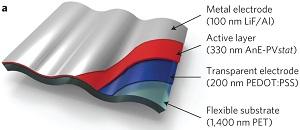Using AI to control energy for indoor agriculture
30 September 2024
Published online 13 August 2013

Light emitting diodes (LEDs) light up our world, from street lights to digital tablets. But a new form of LED display is so thin and flexible it could move with fabric or stuck to biological tissue.
A team of researchers including Safae Aazou of the Chouaib Doukkali University, Morocco, have made a red and orange polymeric LEDs that, unlike traditional LEDS, are ultrathin, highly flexible and stretchable, publishing their design in Nature Photonics.
They sandwiched a thin layer of semiconductor photo-emitting material between a metal and a transparent organic electrode, all fixed on top of a thicker flexible polymeric substrate. This allows the diode to be bent and stretched while still being able to work. The entire setup does not exceed two micrometers in thickness.
Stress tests on this 'polymeric' LED, or PLED, using a glass substrate for reference, demonstrated an unprecedented toleration to being flexed and stretched, with values approaching those of conventional elastic materials.
The polymeric LED can be used as a free-standing foil or integrated with deformable materials such as textiles and biological tissue. The same design concept can be applied with semiconductors emitting photons of different colours. This offers vast potential applications in medicine, as well as the communications, infrastructure and security industries.
doi:10.1038/nmiddleeast.2013.125
Stay connected: